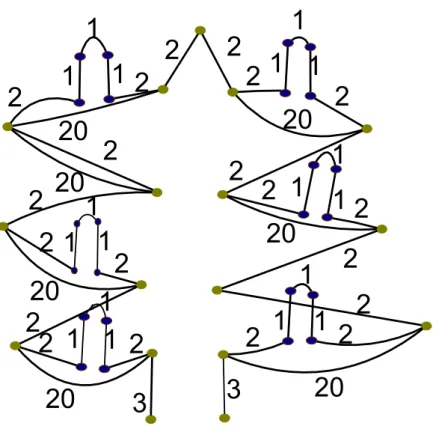Exercise 8: Don’t get Lost
Task 1: . . . everything is (probably) going to be fine
An event occurs with high probability (w.h.p.), if its probability is, for any choice of c ∈R≥1, at least 1−n−c. Heren is the input size (in our case,n =|V|), and c is a (user-provided) parameter, very much like thein a (1 +)-approximation algorithm.
This exercise shows nice properties of “w.h.p.”, especially why it works so easily under composition.
Algorithm 1Code for generating a random ID at nodev.
1: idv← dclognerandom bits from independent, fair sources
a) Suppose that some algorithm A is called ten times, and each call succeeds w.h.p.
Pick c such that forn ≥10, all ten calls of A all succeed with a probability of at least 0.999.
Hint: Union bound.
b) Let E1, . . . ,Ek be polynomially many events, i.e.,k∈nO(1), each of them occurring w.h.p. Show thatE:=E1∩ · · · ∩ Ek, the event that allEi happen, occurs w.h.p.
c) Consider Algorithm 1, which generates random node IDs. Fix two distinct nodes v, w∈V and show that w.h.p., they have different IDs.
d) Show that w.h.p., Algorithm 1 generates pairwise distinct node IDs.
Task 2: . . . in the Steiner Forest!
In this exercise, we’re going to find a 2-approximation for the Steiner Tree problem on a weighted graph G = (V, E, W), as defined in an earlier exercise; we use the Congest model. Denote by T the set of nodes that need to be connected, and by GT = (T, T2
, WT) the terminal graph.
a) For each node v, denote by t(v) the closest node in T. Show that all v ∈ V can determinet(v) along with the weighted distance dist(v, t(v)) in
maxv∈V{hop(v, t(v))}+O(D)
rounds,1 where hop(v, t(v)) denotes the hop length of the minimum-weight distance path fromv tot(v).
Hint: This essentially is a single-source Moore-Bellman-Ford with a virtual source connected to all nodes inT.
b) Consider a terminal graph edge {t(v), t(w)} “witnessed” by G-neighbors v and w witht(v)6=t(w), i.e.,vandwknow that dist(t(v), t(w))≤dist(t(v), v) +W(v, w) + dist(w, t(w)). Show that if there are no suchvandwwith dist(t(v), t(w)) = dist(v, t(v))+
W(v, w) + dist(w, t(w)), then{t(v), t(w)} is not in the MST ofGT!
Hint: Observe that G is partitioned into Voronoi cells Vt = {v ∈ V | t(v) = t}, and that in the above case any shortestt(v)-t(w) path must contain a nodeuwith t(u)∈ {t(v), t(w)}, i.e., cross a third Voronoi cell. Conclude that/ {t(v), t(w)} is the heaviest edge in the cycle (t(v), t(u), t(w), t(v)).
1These are partial shortest-path trees rooted in eacht∈T.
c) Show that an MST ofGT can be determined and made globally known inO(|T|+D) additional rounds.
Hint: Use the distributed variant of Kruskal’s algorithm from the lecture.
d) Show how to construct a Steiner Tree ofGof at most the same weight as the MST of the terminal graph in additional maxv∈V{hop(v, t(v))}rounds.
Hint: Modify the previous step so that the “detecting” pairv, wwith dist(t(v), t(w)) = dist(v, t(v))+W(v, w)+dist(w, t(w)) is remembered. Then mark the respective edges {v, w}and the leaf-root-paths fromvtot(v) andwtot(w) for inclusion in the Steiner Tree.
e) Conclude that the result is a 2-approximate Steiner Tree. What is the running time of the algorithm?
Hint: Recall Task 2 from Exercise 6.
Task 3*: . . . under a Heap of Presents
weight RGB
1 (255,255,0) 2 (34,139,34) 3 (165,42,42) 5 (255,0,0) 20 (193,255,244)
a) Determine an MST of the graph given in Figure 1!
b) Color each MST edge. The edge colors are given in the table above, i.e., an edge of weight 1 has color (255,255,0).
c) Look for other Christmas trees in the computer science literature!
Hint: xkcd.
d) Have a Merry Christmas and a Happy New Year!
Figure 1: Poorly disguised Christmas tree.
